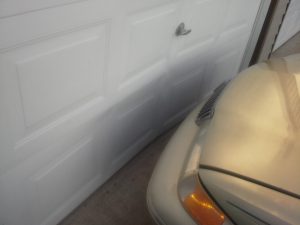
Own an aluminum or steel garage door long enough, and you will eventually also own garage door dents. This is especially true if you have kids: soccer balls, baseballs, teen drivers and horseplay can wreak havoc on your garage door. Dents can become quite unsightly — making your door look ragged and in need of repair. Your home’s overhead garage door is an important part of your home’s curb appeal, and we all know curb appeal is a significant factor in the value of your home. So your garage door looks….well, kind of awful. What can you do besides take on the cost of replacing it? Remove the dents yourself!
Repairing Dents on an Aluminum Garage Door
Fortunately, repairing dents on an aluminum garage door are an easy DIY garage door repair if you know this simple trick. Not only will you fix your garage door, you might also impress the neighborhood kids. This trick is science in action — a way to contract the deformed metal and repair your garage door. You’ll need:
- Lighter/heat source
- Aluminum Foil
- Compressed Air
Before you begin, gently clean the dent and surrounding area on the panel and allow it to dry. Then, cover the dent with enough aluminum foil to press into the shape of the dent and still have some extra edge to hold it still without burning your fingers in the next step. Once you’ve done this, use your heat source to heat the area for about 60 seconds; you can use anything from a lighter to a blow dryer. Just make sure you’ve heated the area long enough that the entire dent is warm.
Next, remove the foil, and as quickly as possible, holding your compressed air can upside down, spray the dent for 30 seconds. You may notice some liquid coming out of the compressed air – be careful not to get it on your skin, as it can burn.
Once you’re done, you should see the dent slowly moving back into place.
Why does it work? In simple terms, metal will contract and expand when it changes temperatures. The lighter will heat up the metal and the compressed air will lower it with the freezing liquid. By nature, when you dent metal, you’re stretching it into a new shape, so heating the dent and then quickly cooling it causes a reaction that makes the metal want to return to its original form by contracting back to its intended shape.
Fixing a Dented Steel Garage Door
Repairing dents in a steel garage door is an entirely different process, but it’s just as simple. You basically prep the dented area by cleaning it and letting it dry, and then you fill the dent with a special putty. It’s much like patching drywall. After the mixture dries, you sand the filled area until it’s as smooth as the rest of the panel, and paint to match the rest of the door. Simple as that!
Replacing a Dented Garage Panel
If your dent is more than a few inches in size, there’s a good chance that you will need to have a technician inspect the track and garage door parts for other damage. The most common issue with a dented garage panel is that it becomes off balance. An unbalanced door can wear out the opener and lead to other problems.
Fortunately, this isn’t a serious issue as long as you take care of it promptly.
If the dent is significant enough that it has caused damage to several of the garage door’s parts or the garage door opener, however, you may want to consider replacing the door entirely. If you’re not sure, you can call a garage door repair company and describe the damage. Here at Sacs our technicians are always happy to offer you their expert opinion, or come to your home to diagnose the extent of the damage and give their best recommendation.
Should You Replace Your Dented Garage Door?
If two or more panels are badly dented, rotted or corroded, you might be better off just replacing the door with a new garage door. Like anything else, garage doors will wear out eventually. If the door is badly bent by a car, for example, you should probably just install a new garage door. It will look sleeker and more professional than trying to fix each panel individually. A new garage door cost isn’t usually something a family prepares for financially, and it may not seem all that rewarding, but it will keep your home’s curb appeal attractive and keep your household running without any problems.
More good news about replacing a broken garage door is that new garage doors have one of the highest returns on investment for all home improvements: nearly 97% – virtually dollar for dollar. If the door is dented enough to be an eyesore and the tricks above didn’t do much, you should probably opt for a new door; It’ll be worth it in the long run.
